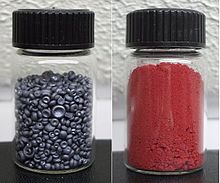 Type: Trace Element
Type: Trace Element
Periodic Element: (Se)
RDA: 0.05-2 mg
Importance- To Body:
Constituent of certain enzymes;, lipid metabolism, Antioxidant; (protects plasma membranes from breaking down), spares vitamin E.
Distribution- In Body:
* Approx. % of Body Mass
Stored in liver, kidneys.
Excess Effects:
Gastrointestinal disorders, lung irritation, Nausea, vomiting, irritability, fatigue
Deficiency Effects:
Anemia (Rare)
Sources Food:
Most foods, especially liver, Meats, seafood, cereals
Sources Environmental/Geographic:
None listed
Supplemental information:
 |
|||||||||||||||||||||||||||||||||||||||||||||||||||||||
| General properties | |||||||||||||||||||||||||||||||||||||||||||||||||||||||
|---|---|---|---|---|---|---|---|---|---|---|---|---|---|---|---|---|---|---|---|---|---|---|---|---|---|---|---|---|---|---|---|---|---|---|---|---|---|---|---|---|---|---|---|---|---|---|---|---|---|---|---|---|---|---|---|
| Pronunciation | /sɪˈliːniəm/ |
||||||||||||||||||||||||||||||||||||||||||||||||||||||
| Appearance | black, red, and gray (not pictured) allotropes | ||||||||||||||||||||||||||||||||||||||||||||||||||||||
| Standard atomic weight (Ar, standard) | 78.971(8) | ||||||||||||||||||||||||||||||||||||||||||||||||||||||
| Selenium in the periodic table | |||||||||||||||||||||||||||||||||||||||||||||||||||||||
|
|||||||||||||||||||||||||||||||||||||||||||||||||||||||
| Atomic number (Z) | 34 | ||||||||||||||||||||||||||||||||||||||||||||||||||||||
| Group | group 16 (chalcogens) | ||||||||||||||||||||||||||||||||||||||||||||||||||||||
| Period | period 4 | ||||||||||||||||||||||||||||||||||||||||||||||||||||||
| Element category | polyatomic nonmetal, sometimes considered a metalloid | ||||||||||||||||||||||||||||||||||||||||||||||||||||||
| Block | p-block | ||||||||||||||||||||||||||||||||||||||||||||||||||||||
| Electron configuration | [Ar] 3d10 4s2 4p4 | ||||||||||||||||||||||||||||||||||||||||||||||||||||||
|
Electrons per shell
|
2, 8, 18, 6 | ||||||||||||||||||||||||||||||||||||||||||||||||||||||
| Physical properties | |||||||||||||||||||||||||||||||||||||||||||||||||||||||
| Phase at STP | solid | ||||||||||||||||||||||||||||||||||||||||||||||||||||||
| Melting point | 494 K (221 °C, 430 °F) | ||||||||||||||||||||||||||||||||||||||||||||||||||||||
| Boiling point | 958 K (685 °C, 1265 °F) | ||||||||||||||||||||||||||||||||||||||||||||||||||||||
| Density (near r.t.) | gray: 4.81 g/cm3 alpha: 4.39 g/cm3 vitreous: 4.28 g/cm3 |
||||||||||||||||||||||||||||||||||||||||||||||||||||||
| when liquid (at m.p.) | 3.99 g/cm3 | ||||||||||||||||||||||||||||||||||||||||||||||||||||||
| Critical point | 1766 K, 27.2 MPa | ||||||||||||||||||||||||||||||||||||||||||||||||||||||
| Heat of fusion | gray: 6.69 kJ/mol | ||||||||||||||||||||||||||||||||||||||||||||||||||||||
| Heat of vaporization | 95.48 kJ/mol | ||||||||||||||||||||||||||||||||||||||||||||||||||||||
| Molar heat capacity | 25.363 J/(mol·K) | ||||||||||||||||||||||||||||||||||||||||||||||||||||||
Vapor pressure
|
|||||||||||||||||||||||||||||||||||||||||||||||||||||||
| Atomic properties | |||||||||||||||||||||||||||||||||||||||||||||||||||||||
| Oxidation states | 6, 5, 4, 3, 2, 1, −1, −2 |
||||||||||||||||||||||||||||||||||||||||||||||||||||||
| Electronegativity | Pauling scale: 2.55 | ||||||||||||||||||||||||||||||||||||||||||||||||||||||
| Ionization energies |
|
||||||||||||||||||||||||||||||||||||||||||||||||||||||
| Atomic radius | empirical: 120 pm | ||||||||||||||||||||||||||||||||||||||||||||||||||||||
| Covalent radius | 120±4 pm | ||||||||||||||||||||||||||||||||||||||||||||||||||||||
| Van der Waals radius | 190 pm | ||||||||||||||||||||||||||||||||||||||||||||||||||||||
|
|||||||||||||||||||||||||||||||||||||||||||||||||||||||
| Miscellanea | |||||||||||||||||||||||||||||||||||||||||||||||||||||||
| Crystal structure | hexagonal | ||||||||||||||||||||||||||||||||||||||||||||||||||||||
| Speed of sound thin rod | 3350 m/s (at 20 °C) | ||||||||||||||||||||||||||||||||||||||||||||||||||||||
| Thermal expansion | amorphous: 37 µm/(m·K) (at 25 °C) | ||||||||||||||||||||||||||||||||||||||||||||||||||||||
| Thermal conductivity | amorphous: 0.519 W/(m·K) | ||||||||||||||||||||||||||||||||||||||||||||||||||||||
| Magnetic ordering | diamagnetic | ||||||||||||||||||||||||||||||||||||||||||||||||||||||
| Magnetic susceptibility | −25.0·10−6 cm3/mol (298 K) | ||||||||||||||||||||||||||||||||||||||||||||||||||||||
| Young's modulus | 10 GPa | ||||||||||||||||||||||||||||||||||||||||||||||||||||||
| Shear modulus | 3.7 GPa | ||||||||||||||||||||||||||||||||||||||||||||||||||||||
| Bulk modulus | 8.3 GPa | ||||||||||||||||||||||||||||||||||||||||||||||||||||||
| Poisson ratio | 0.33 | ||||||||||||||||||||||||||||||||||||||||||||||||||||||
| Mohs hardness | 2.0 | ||||||||||||||||||||||||||||||||||||||||||||||||||||||
| Brinell hardness | 736 MPa | ||||||||||||||||||||||||||||||||||||||||||||||||||||||
| CAS Number | 7782-49-2 | ||||||||||||||||||||||||||||||||||||||||||||||||||||||
| History | |||||||||||||||||||||||||||||||||||||||||||||||||||||||
| Naming | after Selene, Greek goddess of the moon | ||||||||||||||||||||||||||||||||||||||||||||||||||||||
| Discovery and first isolation | Jöns Jakob Berzelius and Johann Gottlieb Gahn (1817) | ||||||||||||||||||||||||||||||||||||||||||||||||||||||
| Main isotopes of selenium | |||||||||||||||||||||||||||||||||||||||||||||||||||||||
|
|||||||||||||||||||||||||||||||||||||||||||||||||||||||
Selenium is a chemical element with symbol Se and atomic number 34. It is a nonmetal with properties that are intermediate between the elements above and below in the periodic table, sulfur and tellurium, and also has similarities to arsenic. It rarely occurs in its elemental state or as pure ore compounds in the Earth's crust. Selenium (from Ancient Greek σελήνη (selḗnē) "Moon") was discovered in 1817 by Jöns Jacob Berzelius, who noted the similarity of the new element to the previously discovered tellurium (named for the Earth).
Selenium is found in metal sulfide ores, where it partially replaces the sulfur. Commercially, selenium is produced as a byproduct in the refining of these ores, most often during production. Minerals that are pure selenide or selenate compounds are known but rare. The chief commercial uses for selenium today are glassmaking and pigments. Selenium is a semiconductor and is used in photocells. Applications in electronics, once important, have been mostly replaced with silicon semiconductor devices. Selenium is still used in a few types of DC power surge protectors and one type of fluorescent quantum dot.
Selenium salts are toxic in large amounts, but trace amounts are necessary for cellular function in many organisms, including all animals. Selenium is an ingredient in many multivitamins and other dietary supplements, including infant formula. It is a component of the antioxidant enzymes glutathione peroxidase and thioredoxin reductase (which indirectly reduce certain oxidized molecules in animals and some plants). It is also found in three deiodinase enzymes, which convert one thyroid hormone to another. Selenium requirements in plants differ by species, with some plants requiring relatively large amounts and others apparently requiring none.



